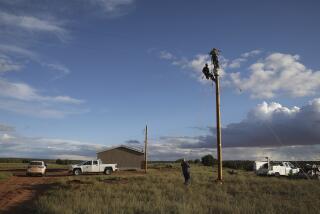Is Asthma Harder on the Poor? : Health: Researchers are trying to determine why deaths from the disease are rising--especially in the inner cities.
- Share via
Spurred by what they say is a dramatically increased asthma death rate--especially among the poor--physicians across the nation have begun asking many questions about the chronic disease, which impairs sufferers’ ability to breathe. The National Institute of Allergy and Infectious Diseases this year will spend $1 million to study the incidence of asthma among children living in America’s inner cities.
Blacks die of asthma more frequently than whites, at a rate of almost three per 100,000 people, compared to 1.5 per 100,000 whites, according to the American Academy of Allergy and Immunology in Milwaukee.
Nationally, the incidence of death by all asthma patients rose from 2,600 in 1979 to 4,580 by 1988, said Sarah Kaluzny, communications manager for the American Academy of Allergy and Immunology. Three years ago, an epidemiological study showed that the death rate for blacks was twice that of whites.
Theories about increased asthma deaths among the poor vary. Some physicians blame air pollution or inability to obtain adequate medical care. Others blame allergies to mites, household dust and roaches. “Drugs are very expensive, and that may be why blacks are not getting adequate care,” Kaluzny said. “Asthma plugs up the lung and swells airways. They’ll usually need one medication for the swelling and another to deal with the mucous buildup that strangles a lot of asthmatics.”
Though the nation’s health officials have documented a startling rise in asthma deaths, no one knows whether the number of people who contract the disease also has increased as well. Physicians are not required to report cases of asthma to thS. Centers for Disease Control in Atlanta, as they must with infectious diseases like tuberculosis and AIDS.
Estimates are that 10 million Americans have asthma, including 3 million under age 18. Studies have shown that adults over age 50 and children under age 9 are at greatest risk of succumbing to an asthma attack, Kaluzny said.
Elderly blacks die of asthma at about the same rate as elderly whites, said Dr. Michael Sly, an allergist and researcher for George Washington University Hospital in Washington.
But the ratio of asthma deaths among the young tells another story: Black males ages 5 to 45 are six times more likely to die of asthma. Black females in that age group are 4 1/2 times more likely to die than whites, Sly said.
Many physicians suspect poverty lies at the root of those statistics.
“The problem is with people who don’t qualify for Medicaid, but who don’t make a lot of money. We try to have drug companies get involved and supply medications at no cost or at a small cost,” said Dr. Amar Sharma, chief of St. Luke Hospital’s allergy section. “Or we can give them samples (of drugs) at the office to tide them over.”
“Asthma is a chronic disease that requires constant care,” said Dr. Floyd Malveaux, a Baltimore physician now studying patients who’ve ended up in the Johns Hopkins University Hospital emergency room with acute asthma.
“We can’t seem to be able to pinpoint any one thing that is responsible. It is probably socioeconomic conditions, and that implies a lot of things,” Malveaux said. “People probably don’t have the same access to medical care for treating asthma.”
Fifty-nine percent of the patients Malveaux has interviewed in the Johns Hopkins emergency room did not have steady employment or health insurance. Some had Medicaid, but others did not.
About 100 of the 300 people in his study rely on the emergency room for their health care. They do not have a regular physician, so they go to the hospital when they can’t breathe well.
The remaining 200 patients use a public clinic for care.
“They don’t have a physician they can call for advice. You call the clinic and they give you an appointment weeks in advance. You just don’t manage asthma that way. The medications need to be adjusted and checked regularly,” Malveaux said.
Asthma--in both rich and poor patients--can be triggered by allergens like pollen, as well as exercise, cold and infection. Dr. Mark P. Shampaign, an Allentown allergist, has treated inner-city children who are sensitive to roaches and dust mites. Chronic exposure to these allergens, he said, conspires with other factors like cold weather to make the lungs vulnerable.
Though most lung specialists say poverty is the main factor escalating the rate of asthma deaths in America, one Allentown area physician believes that Puerto Ricans may be genetically more susceptible to the disease. Dr. Jane Borish, medical director for the Family Health Services Center of the Visiting Nurses Assn. of Lehigh County, said she sees a large number of Latinos with asthma, 90%-95% of whom are Puerto Rican.
“Puerto Ricans are genetically and culturally distinct,” she said, because they live on an island. “Both the adults and children have a number of inherent diseases. Asthma is one of them.”
Borish based her theory on experience rather than research or statistics. “I’m speaking as a physician who sees a lot of patients who are Puerto Rican and poor,” she said. “I can’t talk about the well-to-do Puerto Ricans.”
More to Read
Sign up for Essential California
The most important California stories and recommendations in your inbox every morning.
You may occasionally receive promotional content from the Los Angeles Times.













